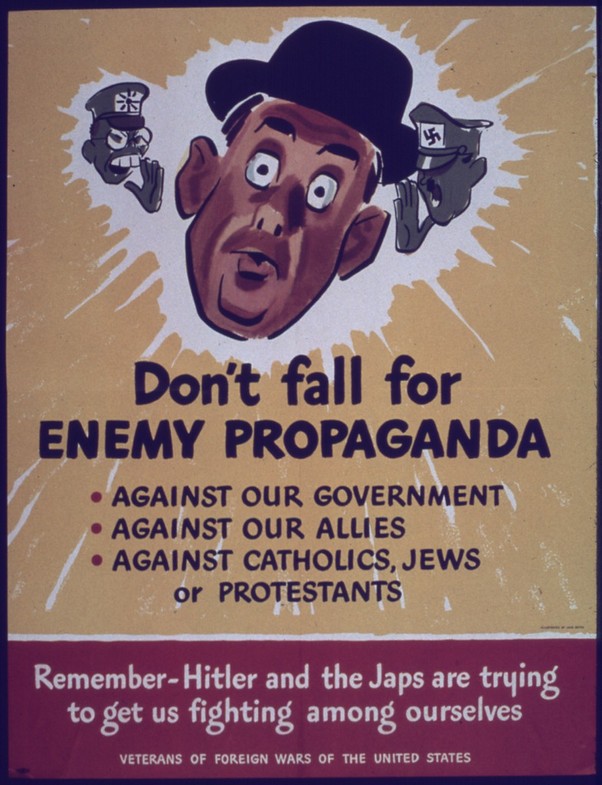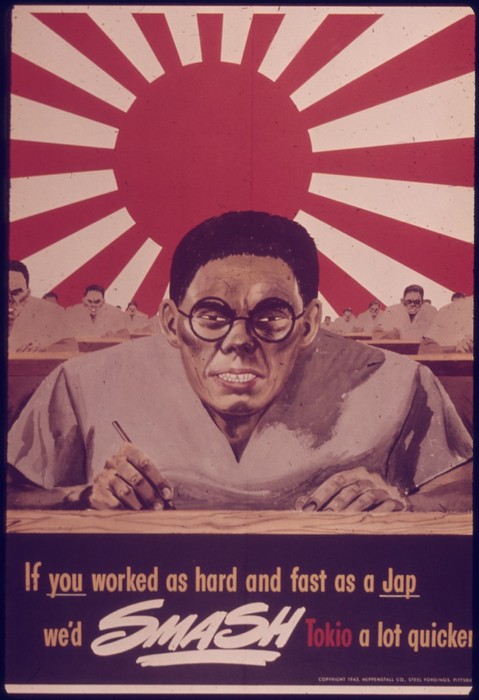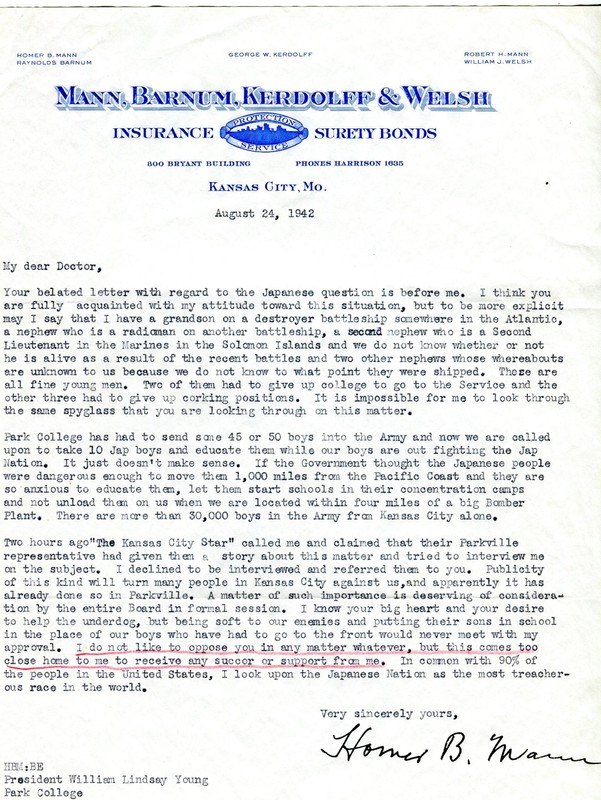Local Perspectives reflect National Sentiments - Homer Mann
Introduction
Text-to-speech Audio
Many different organizations commissioned propaganda posters during World War II. For example, the Veterans of Foreign Wars, headquartered in Kansas City, published propaganda posters during the war to encourage Americans to support the war effort and remain vigilant against common enemies.
Opposition to Nisei students often reflected Japanese stereotypes that permeated propaganda efforts. The first featured poster below demonstrates a small-scale Japanese caricature. However, this poster also highlights another aspect of anti-Japanese propaganda during World War II. American propaganda separated the German people from Hitler and the Nazi regime while grouping all Japanese civilians with Emperor Hirohito and the Japanese military regime. Establishing Japanese civilians as equally threatening as the Japanese government and military led to a demonization of the entire nation rather than its specific regime of the time. As historian Lon Kurashige highlights, President Roosevelt
"quashed fears about German and Italian enemy aliens in the United States, who, unlike their Japanese counterparts, would escape mass evacuation" (Kurashige 170).
So, while Germany and Italy were also members of the Axis powers and participating in the war, and German and Italian Americans and immigrants experienced cases of incarceration, only Japanese Americans were evacuated and incarcerated at extreme rates. This discernment between the Germans and the Nazi regime as opposed to the Japanese as a whole demonstrates the impact of racial bias during the war.
The message of the propaganda posters below, or that of generalized Japanese characters, is reflected in Homer Mann's letter to Dr. Young. His final statement exclaims that he finds the
"Japanese Nation as the most treacherous race in the world" (Letter from Homer Mann to Dr. Young, Aug. 24, 1942).
His statement reflects the homogenization of the Japanese people, equating all Japanese citizens and descendants into an enemy rather than separating them from their government and military. The difference between the classification of the Japanese entirely as an enemy as opposed to the Nazi regime highlights ingrained racial bias that rose to the surface during the war.
Images
Propaganda poster commissioned by the Veterans of Foreign Wars warning against enemy propaganda, 1941-45.

Propaganda poster generalizing Japanese labor to motivate American workers, 1941-45

Letter from Homer Mann to Dr. William Lindsay Young expressing Opposition to Nisei students, Aug. 24, 1942

Backstory and Context
Text-to-speech Audio
Sources
Daniels, Roger. Asian America: Chinese and Japanese in the United States Since 1850. [N.p.]: University of Washington Press, 2011.
Dower, John W. War without Mercy: Race and Power in the Pacific War. 1st ed. Pantheon Books, 1986.
Finch, Lynette. “Psychological Propaganda: The War of Ideas on Ideas During the First Half of the Twentieth Century.” Armed Forces & Society 26, no. 3 (Spring 2000): 367–86. doi:10.1177/0095327X0002600302.
Klein, Christina. Cold War Orientalism: Asia in the Middlebrow Imagination, 1945-1961. Berkeley: University of California Press, 2003.
Kurashige, Lon. Two Faces of Exclusion: The Untold History of Anti-Asian Racism in the United States. Chapel Hill: The University of North Carolina Press, 2016.
“Letter from Mr. Mann to Dr. Young,” letter from Homer B. Mann to Dr. William Lindsay Young, Aug. 24, 1942. Located in Francis Fishburn Archives and Special Collections, Park University Nisei Collection, Park University, Parkville, MO, ID: PC-L-1942.1.261.
National Archives and Records Administration Collection; ddr-densho-37; 1940s; Courtesy of National Archives and Records Administration; Densho Digital Repository; https://ddr.densho.org/ddr-densho-37/.
Seto, Brandon P. “Paternalism and Peril: Shifting U.S. Racial Perceptions of the Japanese and Chinese Peoples from World War II to the Early Cold War.” Asia Pacific Perspectives 13, no. 1 (2015): 57–78.
World War II Posters, 1942-1945; Office for Emergency Management. Office of War Information. Domestic Operations Branch. Bureau of Special Services, Record Group 44; National Archives and Records Administration – College Park Region (Maryland). https://catalog.archives.gov/id/513498.
"Propaganda poster: 'Don't Fall for Enemy Propaganda,'" Densho Digital Repository, ID#: ddr-densho-37-490, Parent Collection: National Archives and Records Administration Collection. https://ddr.densho.org/ddr-densho-37-490/.
"Propaganda poster: 'If You Worked as Hard and Fast as a Jap,'" Densho Digital Repository, ID#: ddr-densho-37-495, Parent Collection: National Archives and Records Administration Collection. https://ddr.densho.org/ddr-densho-37-495/
“Letter from Mr. Mann to Dr. Young,” letter from Homer B. Mann to Dr. William Lindsay Young, Aug. 24, 1942. Located in Francis Fishburn Archives and Special Collections, Park University Nisei Collection, Park University, Parkville, MO, ID: PC-L-1942.1.261. https://www.jstor.org/stable/community.32855061?searchText=PC-L-1942.1.261&searchUri=%2Faction%2FdoBasicSearch%3FQuery%3DPC-L-1942.1.261%26scope%3DeyJpZCI6ICIzMzI5MzMwNyIsICJwYWdlTmFtZSI6ICJQYXJrIFVuaXZlcnNpdHkgTmlzZWkgQ29sbGVjdGlvbiIsICJwYWdlVXJsIjogIi9zaXRlL3BhcmsvYXJjaGl2ZXMvcGFya3VuaXZlcnNpdHluaXNlaWNvbGxlY3Rpb24tMzMyOTMzMDcvIiwgInR5cGUiOiAiY29tcGlsYXRpb24iLCAicG9ydGFsTmFtZSI6ICJQYXJrIFVuaXZlcnNpdHkiLCAicG9ydGFsVXJsIjogIi9zaXRlL3BhcmsvIn0%253D&ab_segments=0%2Fbasic_search_gsv2%2Fcontrol&refreqid=fastly-default%3A734cfe8f983c19ef82ea8b6e4c45aa46&searchkey=1681256194141
